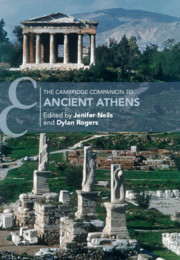Book contents
- The Cambridge Companion to Ancient Athens
- Cambridge Companions to the Ancient World
- The Cambridge Companion to Ancient Athens
- Copyright page
- Contents
- Contributors
- Abbreviations
- Athens: An Introduction
- 1 #Leagros: An Athenian Life
- Part I The Urban Fabric
- Part II Inhabitants
- 11 Population and Social Structure
- 12 The Athenian Family
- 13 Death and Disease
- 14 Animals in Athenian Life
- Part III Business/Commerce
- Part IV Culture and Sport
- Part V Politics
- Reception
- Index
- References
14 - Animals in Athenian Life
from Part II - Inhabitants
Published online by Cambridge University Press: 10 March 2021
- The Cambridge Companion to Ancient Athens
- Cambridge Companions to the Ancient World
- The Cambridge Companion to Ancient Athens
- Copyright page
- Contents
- Contributors
- Abbreviations
- Athens: An Introduction
- 1 #Leagros: An Athenian Life
- Part I The Urban Fabric
- Part II Inhabitants
- 11 Population and Social Structure
- 12 The Athenian Family
- 13 Death and Disease
- 14 Animals in Athenian Life
- Part III Business/Commerce
- Part IV Culture and Sport
- Part V Politics
- Reception
- Index
- References
Summary
According to a variety of ancient sources (texts, inscriptions, archaeology, visual arts), animals were a common sight in the city of Athens. Their behaviors, characteristics, and relationships to humans revolve around the thematic categories of everyday life, mythology and religion, and performance and competition.
- Type
- Chapter
- Information
- The Cambridge Companion to Ancient Athens , pp. 199 - 214Publisher: Cambridge University PressPrint publication year: 2021
References
Further Reading
The growing field of Animals Studies has encouraged recent publications on many aspects of ancient Greek (and thus Athenian) animals; e.g., bovines by McInerney 2010, who reflects on their symbolic value and their many functions within ancient Greek culture; birds by Mynott 2018. The best general introduction is Campbell 2014, with chapters organized according to theme, and covering much that is mentioned here, as well the economy, magic, communication, husbandry, metamorphosis, zoology, etc. For classification, terminology, and species, see Calder 2011; Korhonen and Ruonakoski 2017; and the user-friendly collections of Kitchell 2013, and Lewis and Llewelyn-Jones 2018. Fauna are covered by MacKinnon (in Campbell 2014); Ekroth and Wallensten 2013; and see Liston et al. 2018, for dogs found deposited with infants in a second-century bc well in the Agora. For animal fossils and their connections to mythology, see Mayor (in Campbell 2014). Both Kalof 2011 and Campbell 2014 place Greek animals into a wider ancient context. Hybrid creatures in Athenian literature and art are well covered in Padgett 2003 and Aston 2011, while animal-shaped vessels from Athens and elsewhere are the topic of a recent exhibition and well-illustrated catalogue (Ebbinhaus 2018).
Bibliography
Additional resources to accompany this chapter can be found at: www.cambridge.org/NeilsRogers



